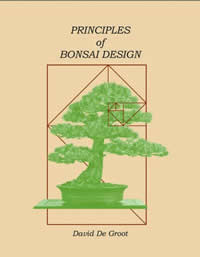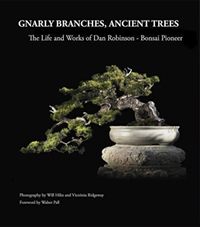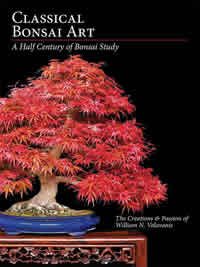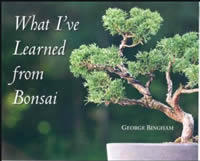I was given a 40-year-old Quince bonsai tree and I would like to get some advice on taking care of it. I have a great book called, Bonsai Basics which has given me some insight as to how to take care of it, but I am looking for more information. I was also wondering about getting the tree repotted and the roots trimmed (which needs to happen very soon, as far as I can gather.) The roots have not been trimmed on this particular tree for about 3 years, and it has survived a pretty hard hit of insect and fungus pests.
The Puget Sound Bonsai Association has a website with useful information and links to other bonsai-related organizations and information. This is an active group with regular meetings, some lectures/workshops, and a good newsletter.
Nurseries such as Bonsai Northwest, a specialty nursery in South Seattle, often offer classes on bonsai care.
I am looking for a class or program that shows how to grow bonsai trees.
The Pacific Northwest Bonsai Clubs Association has a list of bonsai instructors in our area.
Bonsai Northwest, 5021 S. 144th St., Tukwila has classes on bonsai.
Several local nurseries occasionally offer classes or presentations on bonsai, so it would be worthwhile to check the event listings on the Puget Sound Bonsai Association website.
I have a Laburnum grown from RHS seed. I wish to bonsai the tree (it is currently about 2″ high and in the UK). I would like to know when the tree should need root pruning, branch pruning (obviously when it is much bigger). What is the best soil mixture and what should the watering regime be. I have looked in my bonsai books, but Laburnum trees are somewhat neglected. Any help would be appreciated.
I consulted the many bonsai titles in our library, and found only one which mentions Laburnum in the index, The Complete Book of Bonsai by Harry Tomlinson (Abbeville Press, 1991). The book offers no specific pruning directions for Laburnum. I will paraphrase what the author says: The bonsai specimen should receive full sun, and daily watering plus feeding every 2 weeks during the growing season. It should be repotted annually in early spring, using basic soil mix. Trim shoots to 2 or 3 buds. Appropriate bonsai styles for this plant are informal upright, slanting, semi-cascade, cascade, twin trunk, clump, and multiple trunk.
The book Bonsai: The Art of Dwarfing Trees by Ann Kimball Pipe (Meredith Press, 1964) offers general directions on maintaining a bonsai specimen. Pruning of roots and branches is probably best done in early spring before new growth begins.
There are also online resources. The website of the American Bonsai Society, used to have a list of bonsai resources which included this list of articles on bonsai trees, written by Brent Walston. Here are links to a few of the articles:
Root-Pruning Bonsai
Pruning and Pinching
Soils
Watering
Recent Bonsai Books Offer Local and Broader Perspectives
These books profile, or are written by, three of the best-known artists in the American bonsai community. Two of the artists are based in the Puget Sound region.
 David De Groot was the curator of the Pacific Rim Bonsai Collection (now the Pacific Bonsai Museum) in Federal Way for 25 years, until his retirement in 2014. His book Principles of Bonsai Design is the long-awaited new and expanded version of his 1995 classic Basic Bonsai Design. In his new book the author enlarges on his view that bonsai should be considered as a fine art rather than a horticultural novelty. Interestingly, he was a classical musician before becoming a bonsai practitioner, and is a collector of Asian art. There is little information here about how to train trees as bonsais or how to care for them. The emphasis is on choosing a design that references nature, but is a work of art in its own right. The book has many very clear drawings illustrating his points about proportion, balance, container selection and display options. Photographs show examples of trees in nature that can act as inspirations for bonsai design. This is not the book to page through for awe-inspiring pictures of bonsai, but rather to use as a reference when deciding how to convert starting plant material into an aesthetically-pleasing bonsai.
David De Groot was the curator of the Pacific Rim Bonsai Collection (now the Pacific Bonsai Museum) in Federal Way for 25 years, until his retirement in 2014. His book Principles of Bonsai Design is the long-awaited new and expanded version of his 1995 classic Basic Bonsai Design. In his new book the author enlarges on his view that bonsai should be considered as a fine art rather than a horticultural novelty. Interestingly, he was a classical musician before becoming a bonsai practitioner, and is a collector of Asian art. There is little information here about how to train trees as bonsais or how to care for them. The emphasis is on choosing a design that references nature, but is a work of art in its own right. The book has many very clear drawings illustrating his points about proportion, balance, container selection and display options. Photographs show examples of trees in nature that can act as inspirations for bonsai design. This is not the book to page through for awe-inspiring pictures of bonsai, but rather to use as a reference when deciding how to convert starting plant material into an aesthetically-pleasing bonsai.
 The second book, Gnarly Branches, Ancient Trees profiles the life and work of Dan Robinson, written by a friend and fellow bonsai enthusiast, Will Hiltz, with additional photography by Victrinia Ridgeway. Dan Robinson is the owner of Elandan Gardens near Bremerton and is known to many local residents through his display gardens at the Seattle Flower and Garden Show. He trained in forestry and worked for many years as a landscaper. This work, and his posting to Korea while serving in the army in the 1960’s, inspired an interest in bonsai. His bonsai creations are highly original—naturalistic and free-form, in contrast to the refined style of traditional Japanese bonsai. Many originated with trees collected locally from sites where they were surviving under stress, such as in bogs or on rocky mountain peaks. The appeal of this book is not just the story of a local personality in the bonsai community, but also the beautiful photography of the bonsais he has created.
The second book, Gnarly Branches, Ancient Trees profiles the life and work of Dan Robinson, written by a friend and fellow bonsai enthusiast, Will Hiltz, with additional photography by Victrinia Ridgeway. Dan Robinson is the owner of Elandan Gardens near Bremerton and is known to many local residents through his display gardens at the Seattle Flower and Garden Show. He trained in forestry and worked for many years as a landscaper. This work, and his posting to Korea while serving in the army in the 1960’s, inspired an interest in bonsai. His bonsai creations are highly original—naturalistic and free-form, in contrast to the refined style of traditional Japanese bonsai. Many originated with trees collected locally from sites where they were surviving under stress, such as in bogs or on rocky mountain peaks. The appeal of this book is not just the story of a local personality in the bonsai community, but also the beautiful photography of the bonsais he has created.
 Finally, Classical Bonsai Art by William N. Valavanis is both an introduction to the basic techniques and design of bonsai, and also a detailed description of the development of 100 of his bonsai creations over several years. The author is the founder of the International Bonsai Arboretum in Rochester, New York, the organizer of several U.S. National Bonsai Exhibitions and a nationally known bonsai teacher. He relates that his interest in bonsai began when he was 11 years old, and continued through his undergraduate studies in ornamental horticulture. He subsequently made many trips to Japan and apprenticed with famous bonsai masters there. The most fascinating aspect of the book is the insight it gives into the way the author plans a design from his starting material and then manipulates the tree to achieve his goal. He documents the process with detailed photographs often spanning periods of up to 30 years. Along the way we see how he tried out various containers or different orientations of the tree. Each sequence ends with a beautifully-staged photograph of the bonsai in its current state.
Finally, Classical Bonsai Art by William N. Valavanis is both an introduction to the basic techniques and design of bonsai, and also a detailed description of the development of 100 of his bonsai creations over several years. The author is the founder of the International Bonsai Arboretum in Rochester, New York, the organizer of several U.S. National Bonsai Exhibitions and a nationally known bonsai teacher. He relates that his interest in bonsai began when he was 11 years old, and continued through his undergraduate studies in ornamental horticulture. He subsequently made many trips to Japan and apprenticed with famous bonsai masters there. The most fascinating aspect of the book is the insight it gives into the way the author plans a design from his starting material and then manipulates the tree to achieve his goal. He documents the process with detailed photographs often spanning periods of up to 30 years. Along the way we see how he tried out various containers or different orientations of the tree. Each sequence ends with a beautifully-staged photograph of the bonsai in its current state.
 George Bingham is based in Olympia and had been engaged in bonsai for about nine years when “What I’ve Learned from Bonsai” was published in 2008. This very personal book shares his observation about both the art of bonsai and the life lessons he has gained while working with his plants and living with multiple sclerosis.
George Bingham is based in Olympia and had been engaged in bonsai for about nine years when “What I’ve Learned from Bonsai” was published in 2008. This very personal book shares his observation about both the art of bonsai and the life lessons he has gained while working with his plants and living with multiple sclerosis.
Excerpted from the Fall 2012 Arboretum Bulletin.
 Gnarly Branches, Ancient Trees is a biography of Dan Robinson, a bonsai gardener noted for his naturalistic style. While one could learn much from the examples, this is not a how-to book, but rather a celebration of one man’s enthusiasm and perseverance for his art. This led to his establishing Elandan Gardens near Bremerton. His story is well told by the photography and writing of several of his admirers in the local world of bonsai.
Gnarly Branches, Ancient Trees is a biography of Dan Robinson, a bonsai gardener noted for his naturalistic style. While one could learn much from the examples, this is not a how-to book, but rather a celebration of one man’s enthusiasm and perseverance for his art. This led to his establishing Elandan Gardens near Bremerton. His story is well told by the photography and writing of several of his admirers in the local world of bonsai.
Excerpted from the Fall 2012 Arboretum Bulletin.
 David De Groot was the curator of the Pacific Rim Bonsai Collection (now the Pacific Bonsai Museum) in Federal Way for 25 years, until his retirement in 2014. His book
David De Groot was the curator of the Pacific Rim Bonsai Collection (now the Pacific Bonsai Museum) in Federal Way for 25 years, until his retirement in 2014. His book  The second book,
The second book,  Finally,
Finally,  George Bingham is based in Olympia and had been engaged in bonsai for about nine years when “What I’ve Learned from Bonsai” was published in 2008. This very personal book shares his observation about both the art of bonsai and the life lessons he has gained while working with his plants and living with multiple sclerosis.
George Bingham is based in Olympia and had been engaged in bonsai for about nine years when “What I’ve Learned from Bonsai” was published in 2008. This very personal book shares his observation about both the art of bonsai and the life lessons he has gained while working with his plants and living with multiple sclerosis.